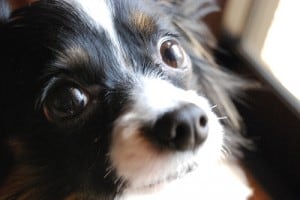Training your Papillon does not have to be a difficult time in your life, or in the life of your dog.
By following a few simple tips and strategies, the process can be pleasant and rewarding for all involved.
The major issue in training a dog is to make sure that your papillon puppy is at the correct stage of its life to be able to understand and internalize the training.
There are seven distinct stages that a puppy goes through, and some stages will foster independence and assertiveness in the puppy, while others will be more “training friendly”.
By understanding these phases and stages you can avoid a lot of frustration and learn to work with the dog, rather than fighting nature.
The focus will be on training a puppy rather than retraining an adult dog. The strategies used will be similar however, and can be interchanged.
Remember that different breeds respond differently to training techniques, and the individual personality of the dog will also impact on the strategies that are most successful.
In addition you should research your breed and talk to trainers about the different stages and temperaments of the breed.
In general hounds and dogs from the working group tend to be high-energy puppies, and may be rambunctious and have difficulty focusing on training exercises.
Toy breeds such as Papillons can tend to be high-strung and prone to barking.
They can also be very stubborn, and usually tend to bond closely with one or two people initially. They can then come to respond to others appropriately later.
Make Training Fun
Make sure that you are in a positive and enthusiastic mood when you begin training sessions. If you are tired, stressed or unhappy this will be communicated to the dog, and it will make the session less pleasant and more difficult.
Take time to praise the puppy when something is done correctly.
Small healthy treats and lots of verbal praise, pets and hugs make the dog feel positive about training sessions.
Try to have a play session at the end of each training session when the session has gone well – this will help the puppy focus on the training.
In addition, always exercise your puppy before the training session starts. This allows their excess energy to be burned off and gives the puppy the opportunity to focus.
If a puppy is not exercised before training, it may be focused on running around and having fun rather than on the business of learning.
Most puppies enjoy learning, being praised, and spending time with their owners. They will look forward to these training times if they are done in a positive atmosphere where the puppy feels successful.
Keep Training Consistent
This is one of the most critical tips for puppies. It is very hard for the puppy to understand expectations if they change from day to day or between people in the house.
Make sure that everyone is using the same commands with the puppy. For example if one person is using “sit” and another is using “down” to get the puppy to sit on its bottom, the puppy will be confused.
This gets even more confusing if, when the puppy jumps up, he is told to “get down”. Keep commands simple and consistent.
In addition to the command language, it is also important to keep the expectations the same between people in the home.
If, for example, the children let the puppy sleep on the bed but the adults insist the puppy stays off the furniture, it will take much longer to teach the puppy.
Good luck, and don’t give up!

